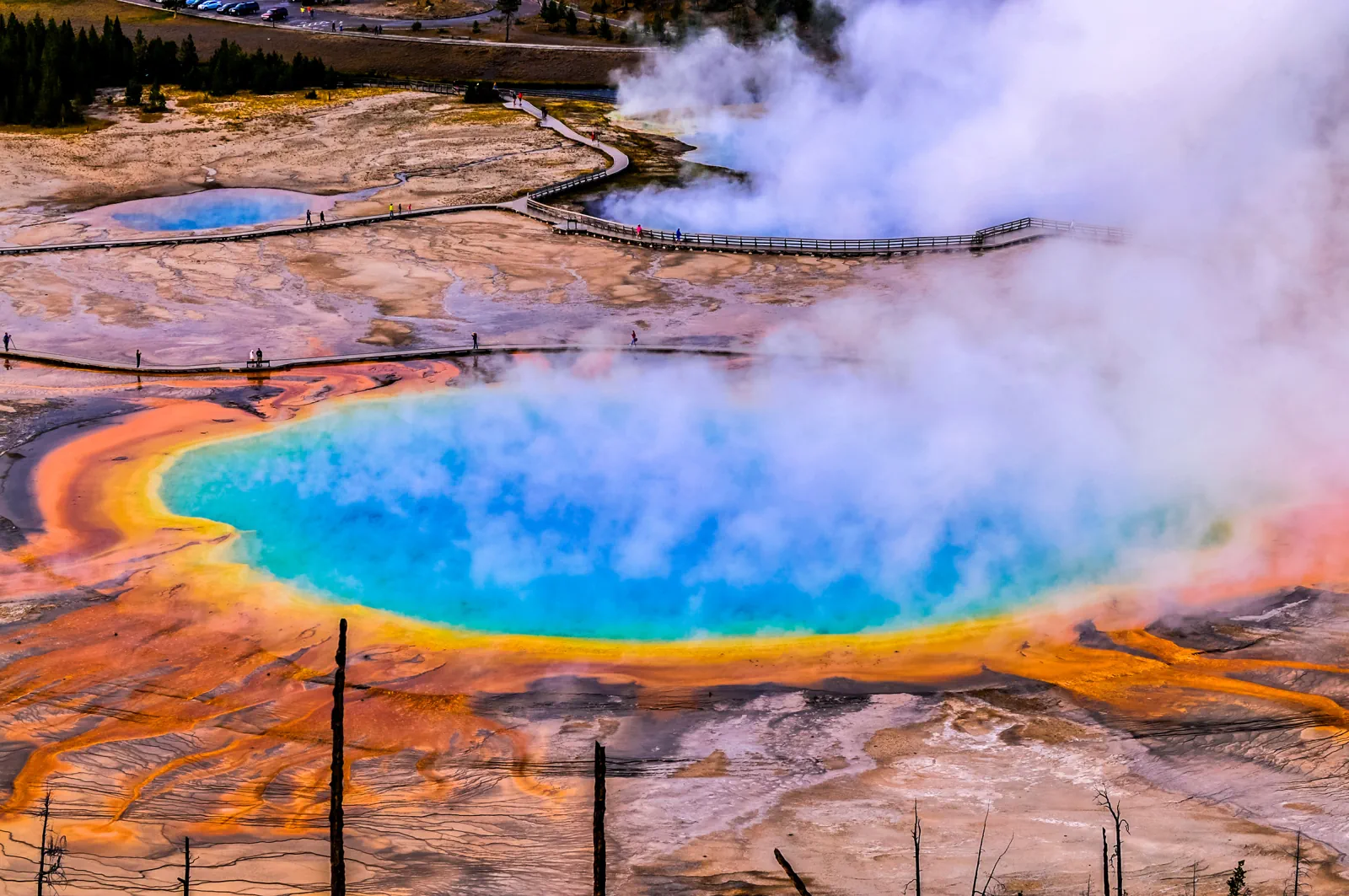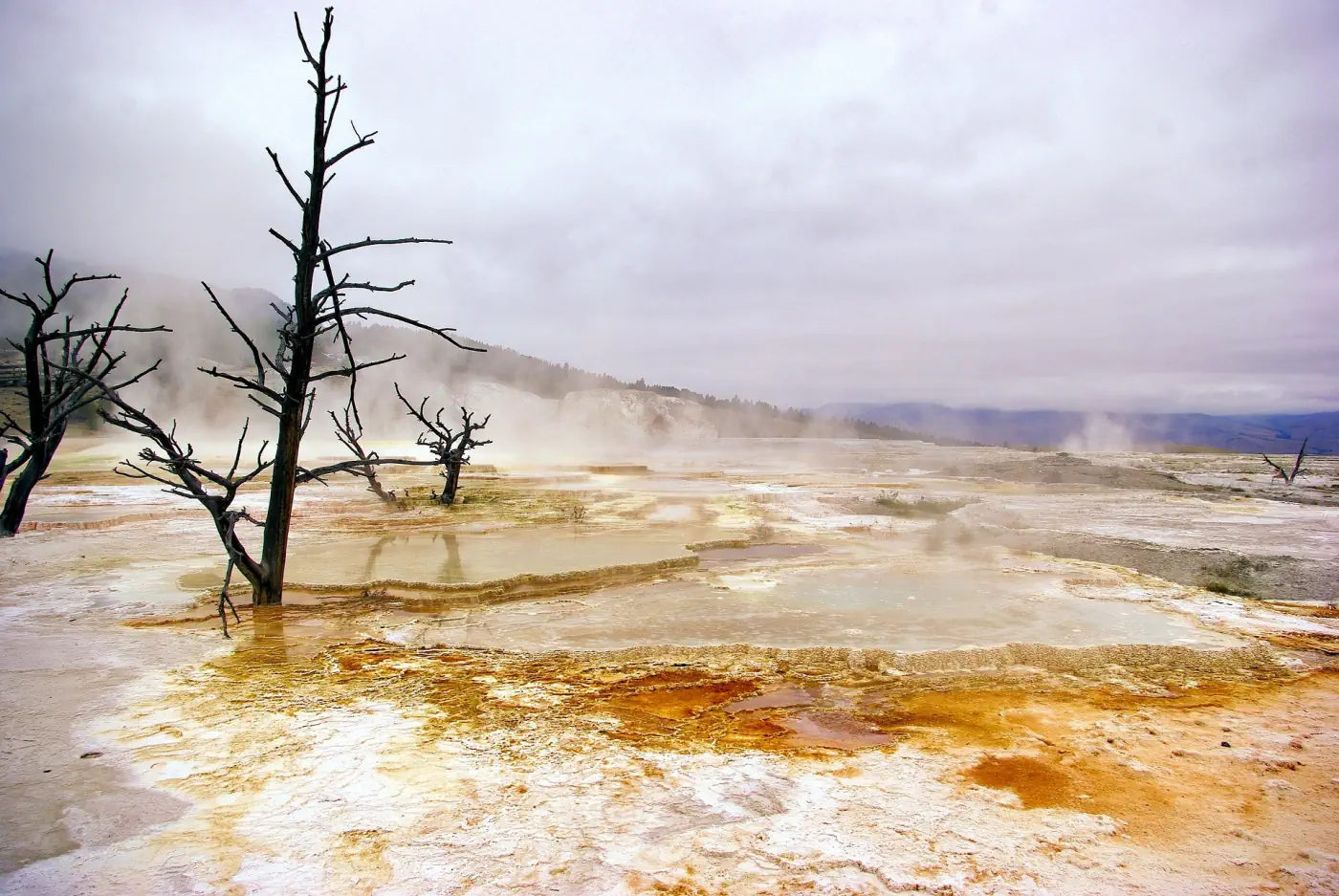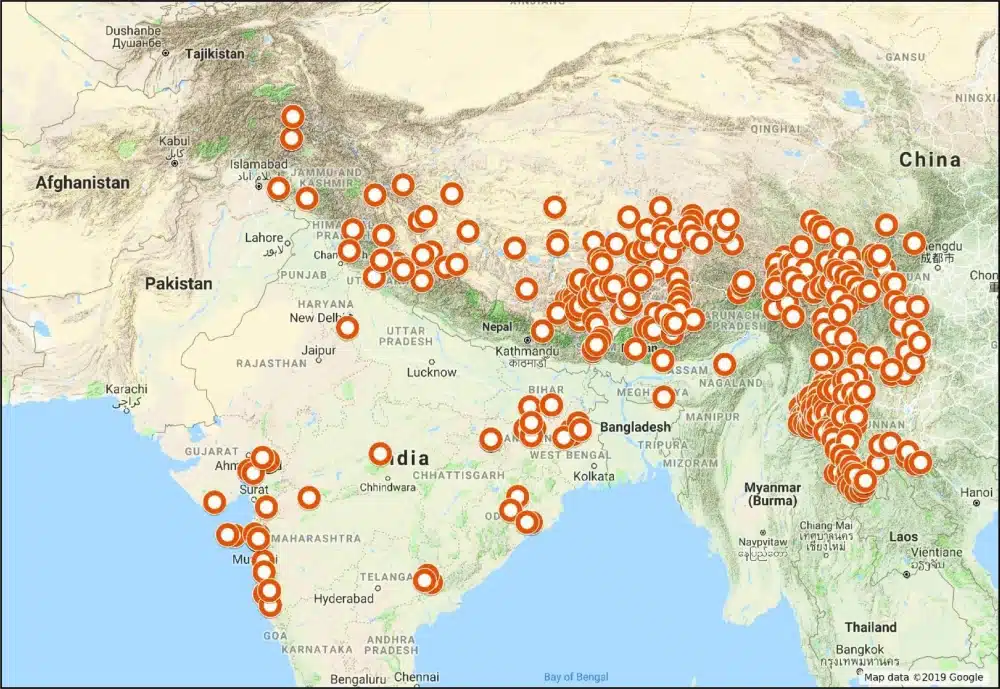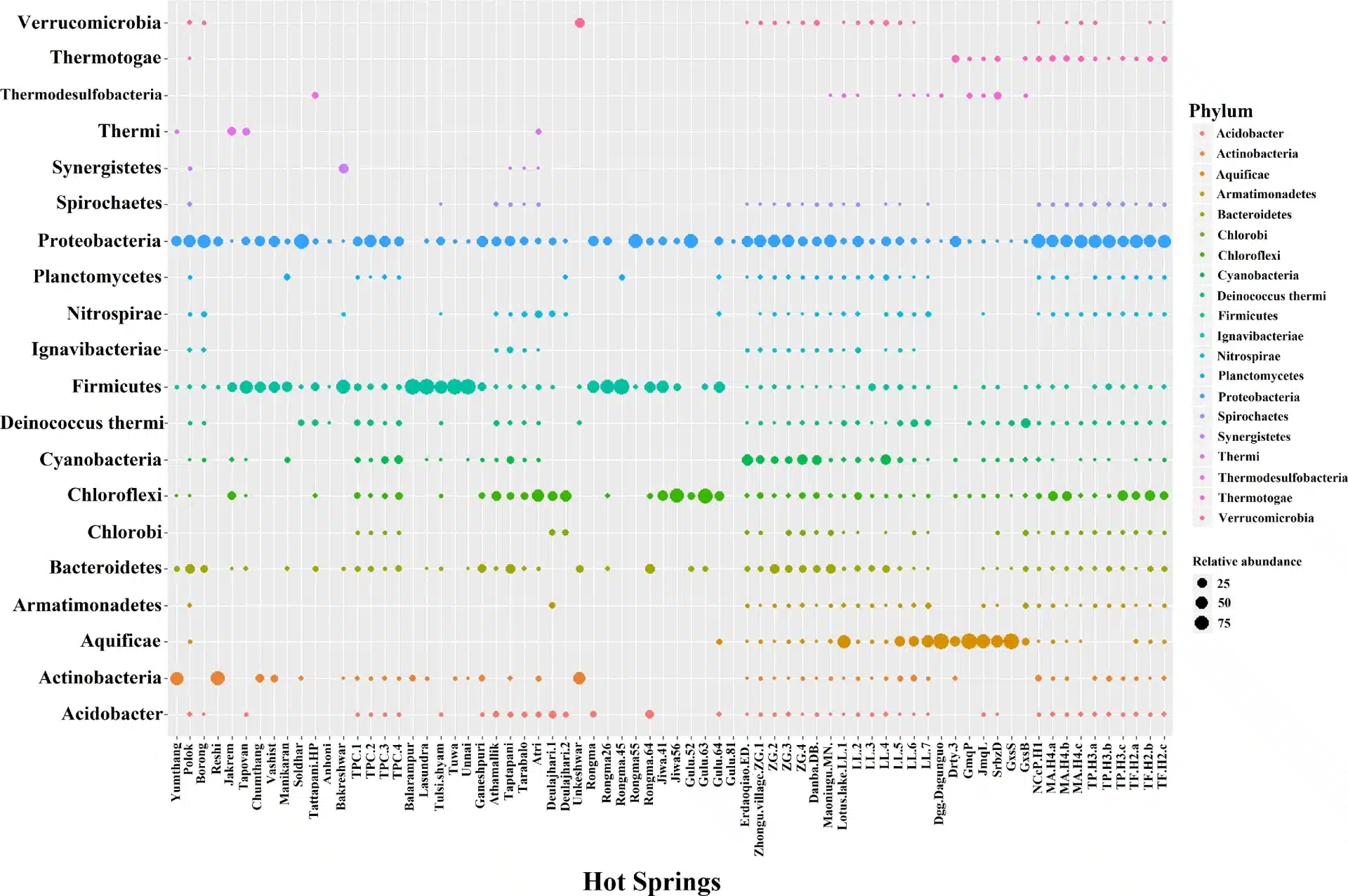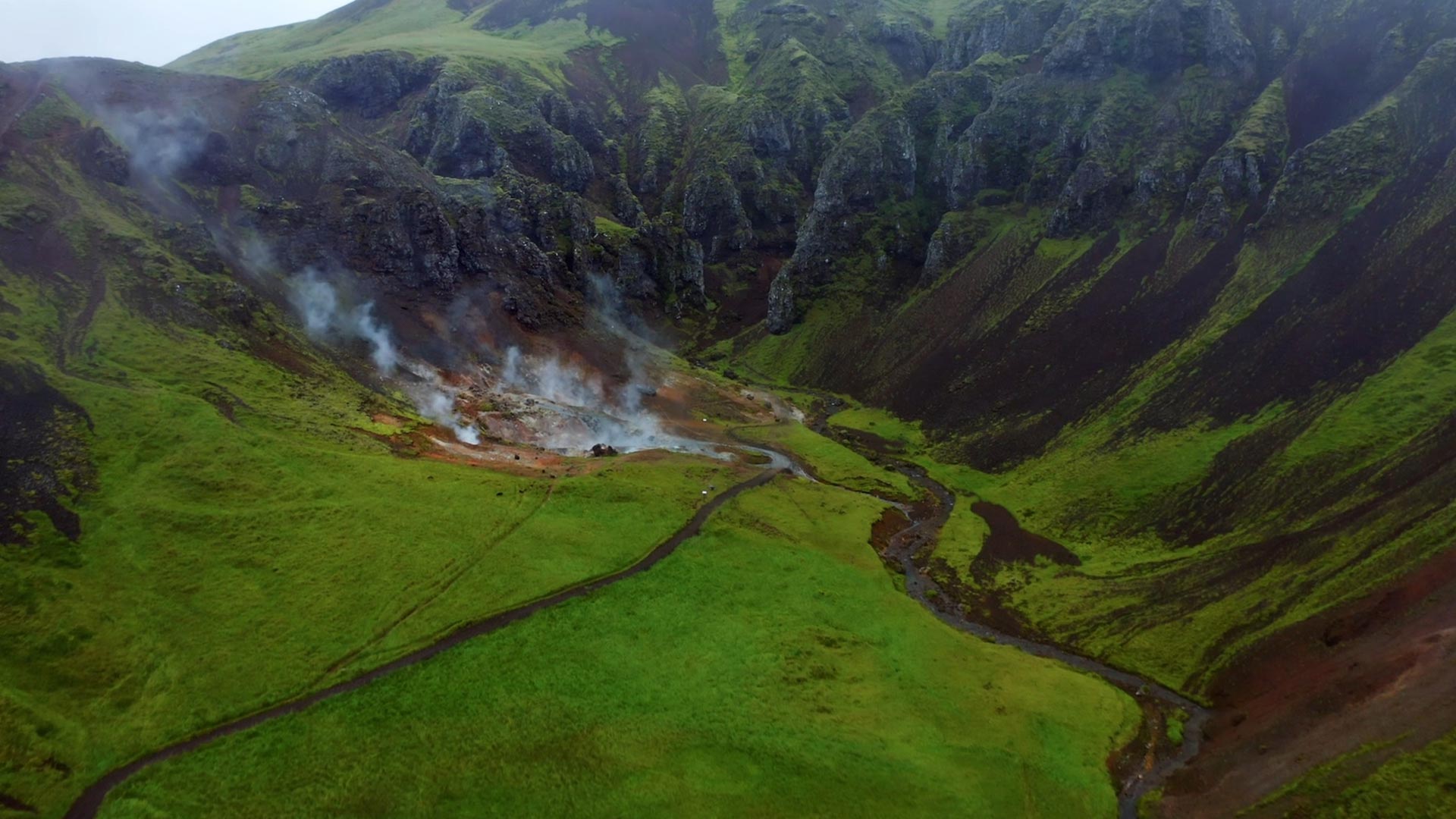The Soil, the Base Layer and Living Medium of a Hot Spring
- Nature Source Chaude
- Published on
- Updated on 2 April 2025
IN SUMMARY :
Soil, the foundation of all life on earth
Soil is essential for eating, drinking and breathing. What keeps us alive depends on soil.
Soil is a true living matrix, adapted to a particular environment. But what about the soil of a hot spring? That’s what we’re going to look at in this article, after discussing the importance of soil micro-organisms. In fact, it is thanks to the presence of a variety of soil micro-organisms that plants, trees, etc. can grow. Without the soil organisms that break down organic matter, there would be no nutrients available to plants.
Soil is the basis of life on all continent. We live on it and from it.
There is an enormous diversity of soil types. Their formation is closely linked to complex interactions between climate, the nature of the substrate (rock), relief, vegetation, micro-organisms and human intervention.
The soil, a living layer that is home to an incredible biological diversity
When we think of biodiversity, we immediately think of things that can be seen, such as animals, plants, trees, insects, etc., but the majority of biodiversity is made up of microbes that cannot be seen. This microbial richness and diversity is present in all environments, such as water, air and especially under our feet: the soil.
A single gram of soil can contain up to 1 billion micro-organisms, while the number of different species can vary from a hundred thousand to a million.
What’s more, all these micro-organisms have an impact on their environment. These micro-organisms can be bacteria, viruses, protozoa, microscopic algae, microscopic fungi, etc. and make up the soil microbiota. Perhaps you’ve heard of the term ‘microbiota’ and the importance of the microorganisms that make it up in humans?
Soil, a living medium at the service of its natural surroundings
We will see in this article that the notion of ‘abundance‘ and ‘diversity‘ of micro-organisms is a fundamental principle in a healthy, balanced living medium. This will enable us to better understand their importance in the soil of a hot spring.
Abundance and diversity of soil micro-organisms in a natural environment
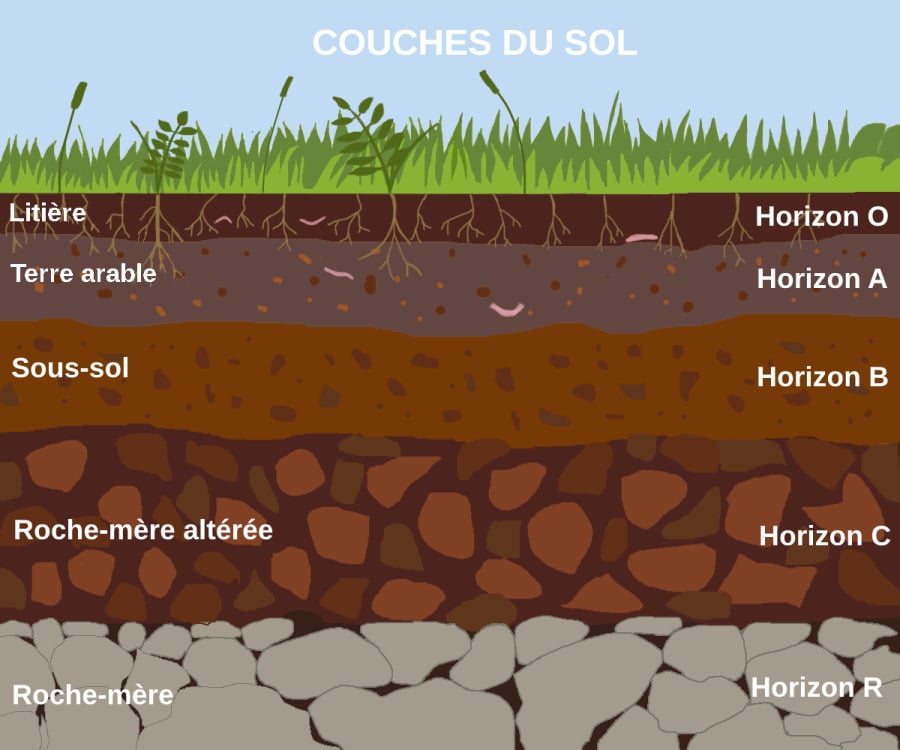
Immediately below the vegetation, we find a large number of micro-organisms (invisible to the naked eye) and animals (earthworms, etc.) distributed in these first two layers:
→ The outermost O layer, also known as ‘litter‘ (Litière in French), is home to a great deal of biological activity. In the first few centimetres, micro-organisms have to break down the accumulated organic matter: freshly fallen plant debris, animal waste and human waste. It consists mainly of humus, plant debris and animal waste.
→ Layer A : Immediately below this is the topsoil (Terre arable in French), which is rich in organic matter and 10 to 30 cm or more thick. It consists of a mixture of humus and minerals and is very important for plant growth.
The presence and diversity of micro-organisms is also very high in the immediate vicinity of plant roots : ferns, grasses, etc.
The further down you go, the poorer the soil becomes in terms of humus. The quantity and diversity of micro-organisms also decreases. Organic matter, which is essential for micro-organisms, becomes scarce. The soil becomes mineral again, but not necessarily sterile. Life abunds in the bowels of the earth. Micro-organisms have been found at depths of up to 5,000 metres, which remains a mystery to scientists.
One indicator of the abundance of micro-organisms is the formation of humus. Humus is the organic matter produced by an entire ecosystem of microscopic creatures that are very active in the top layer of the soil, decomposing organic matter from plant waste (leaves, bark, wood, pollen, etc.) and animal waste.
This process is known as humification. Humus is the blackish-brown soil found in soils. It contains many nutrients useful to plants, including nitrogen, one of the most important.
The role of these soil micro-organisms and their interactions with the surrounding environment
The role of these living organisms in the soil is essential for all the key functions of the soil, such as :
- Maintains the structural condition of the soil by producing organic molecules that hold the soil in cohesion.
- Humidifies the soil.
- Break down and filter pollutants.
- Purification of water.
- Mineralisation of organic matter that can be assimilated by vegetation.
- Increased water retention due to more humus.
- Production of antibiotics to limit the growth of pathogenic bacteria.
- Production of a wide range of enzymes.
Their habitat must be aerated because decomposition and transformation processes generally take place in an oxygen-rich environment where aerobic bacteria live. These micro-organisms play an active role in soil formation, as do earthworms, which help to aerate the soil by digging tunnels.
When the soil is properly humified, it retains water better, ensuring better survival of micro-organisms and better hydration of plants. These micro-organisms use the thin film of water surrounding the soil particles to survive. When the soil dries out, their activity slows down.
Micro-organisms are also particularly active wherever two different environments come together: soil↔air, soil↔plant, etc. The figure below illustrates these reciprocal exchanges between different environments:
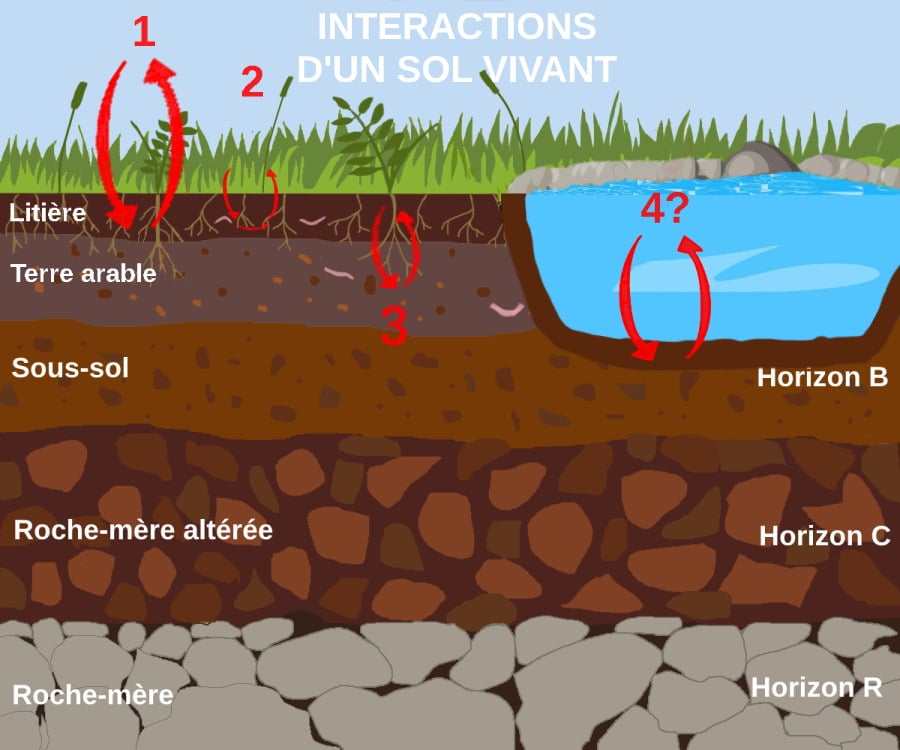
The soil interacts with the surrounding air (1). Soil micro-organisms are directly involved in the nitrogen cycle, but also in the carbon found in the air in the form of a gas: carbon dioxide (CO₂). According to one study[1], they even play a fundamental role in the climate . But in return, according to another study[2], climate change and ‘nitrogen deposits’ from agriculture and combustion are affecting the abundance and diversity of micro-organisms in litter, thereby altering the chemistry of the litter.
There is a rich exchange between the litter and the soil surface (2). A carpet of soil rich in organic matter from dead plants and animals will serve as food for micro-organisms. This food is decomposed, enriching the litter with humus. The mineralisation of the organic matter by these micro-organisms then serves as a nutrient for the plants.
Soil interacts extensively with plants. Although the litter is the richest soil layer in terms of micro-organisms because of its interface with the external environment, these micro-organisms are also particularly abundant around the roots (3), a zone known as the rhizosphere.
Although located outside the plant, this zone is considered to be an organ where a very rich microbial ecosystem lives. This ecosystem is even richer than that found in the plant’s organs (root, leaf, stem, seed, etc.), according to this study[3]. It is even the main microbiota of a plant.
The rhizosphere thus feeds the plant, regulates its root growth and protects it (from parasites, nematodes, etc.). In return, the plant feeds these micro-organisms by transferring organic matter to them. These micro-organisms and plants work together in a variety of interactions[4]. This is called symbiosis. It’s a give and take exchange.
We have seen that soil, through its micro-organisms, supports many exchanges with neighbouring environments. We have also seen that the diversity and abundance of microorganisms is greatest at the interface between two different environments. And finally, that the main microbiota of a plant is located outside, in the rhizosphere. So what happens at the interface between a soil and a hot spring(4)?
Soil, an environment sensitive to external disturbances
So far, we have been able to become a little more aware of the importance of the work of micro-organisms in the soil, since they are considered not only to be the ‘chemical engineers of the soil’, but also the ‘architects of the soil’. They help to create a vast and organised ‘structure‘ throughout the soil at the service of their environment. By preserving this structure, the vegetation that grows in these conditions will be more balanced. On the other hand, a disturbed environment (overgrazing, ploughing, compaction, chemical inputs and various forms of pollution, etc.) reduces the abundance and diversity of micro-organisms, favouring the emergence of opportunistic pathogenic bacteria in a soil that loses quality and fertility.
To compensate for this imbalance and inform us about the state of the soil, nature first provided for the germination of bio-indicator plants (purple dandelion, dandelion, thistle, dock, etc.), which will also stimulate certain micro-organisms, helping to mitigate these effects and correct them over time. But what does all this have to do with a hot spring? What functions might these micro-organisms have in soil hosting a hot spring? That’s what we’re going to try to answer.

The soil, a living medium at the service of a hot spring
When a soil adapts to a hot spring, a dynamic equilibrium between the two is established over time. As mentioned in the introduction, soil is a living matrix that adapts to a given environment, in this case a hot spring. Even in a difficult environment, a hot spring is a dependent source of water. Dependent on what? On its soil.
Transformation of the soil by thermal waters from a hot spring - Presence of micro-organisms
When the water comes out of a hot spring and flows onto the ground for the first time, the soil has to adapt to it. Soil that is permeable or covered with vegetation is not ready to receive thermal water. It turns out that vegetation promotes infiltration by preventing run-off, so how could thermal water run off?
Very rapidly, the presence of vegetation at the point of emergence and in the flow zones is destroyed by the heat conveyed by the thermal waters.
According to a German study[5], repeated hot water treatments are more effective than chemical herbicides in controlling and weeding vegetation on railway tracks. Consequently, permeable soil undergoes a deep transformation of its substrate so that warm water can run off. The soil will acquire a certain capacity to retain water in order to become impermeable.
The temperature of a hot spring seems to be the factor that has the greatest impact on the soil matrix, affecting its mineralogical composition, chemical and morphological properties, etc. When the temperature is high, the alteration of the soil by the thermal water and the most significant changes in its morphology occur.
The presence of chemical elements specific to each hot spring accelerates this phenomenon of soil alteration. But does all this happen without the presence of micro-organisms? Well, no! In fact, the presence of chemical elements[6] and the temperature of the water[7] condition the presence of certain species of micro-organisms, known as thermophiles, which in turn play an active role in the formation or transformation of the soil.
It is worth pointing out here that these factors determine both the presence of micro-organisms that develop in the hot spring and those that develop in the soil.
So the most common type of soil found in a hot spring is generally made up of silt, clay, etc. Without the presence of micro-organisms, the soil would be sandy and unable to hold water. Nutrient-rich clay soils hold water best.
But the contours of some hot springs are sometimes defined in more surprising ways by travertine soil, siliceous agglomerate soil, carbonate soil, a carpet of soil rich in ferrous oxide, and so on.
In any case, the strangeness of these soils always harbours a multitude of micro-organisms. Here are a few examples:
AND TRAVERTINE SOIL
Yellowstone Park is one of the most popular sites for studying the thermophilic bacteria found in hot springs, some of which are highly acidic. The Mammoth Hot Springs area in the north-west of the park is famous for its many limestone concretions and travertine terraces. The most spectacular of these are found in the Lower Terraces area.
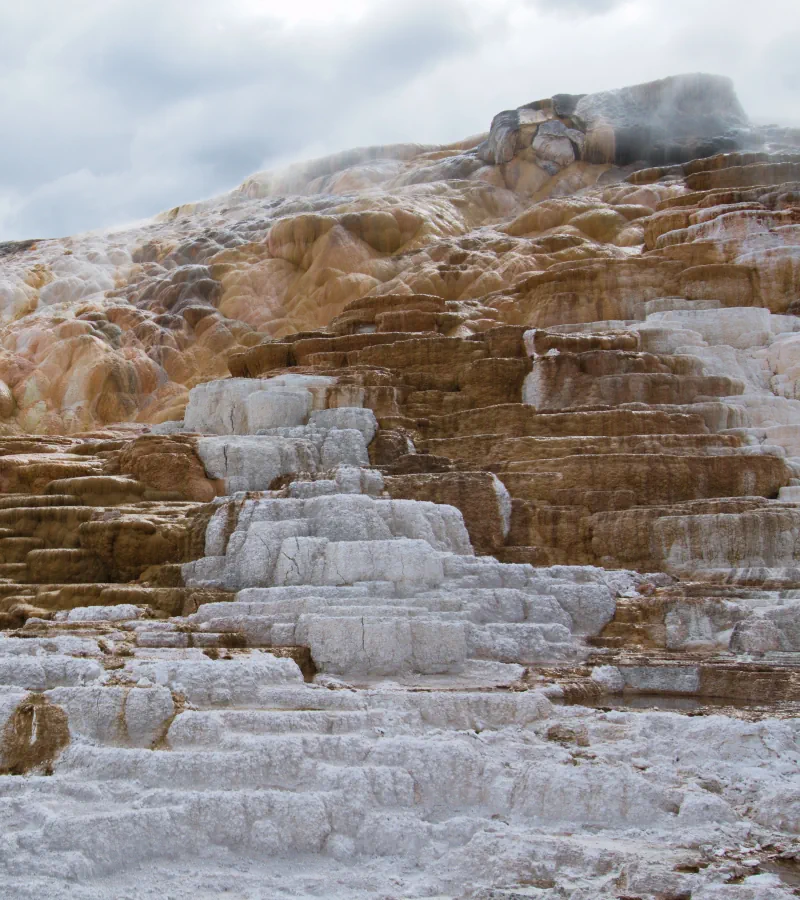
According to these two studies[8][9] carried out at the MAMMOTH HOT SPRINGS site, the formation of these travertines, long thought to be “inert”, is not just the result of the classic chemical reactions that cause limestone deposits, but of complex processes involving micro-organisms on the chemistry of the travertine crystals.
Another study[10] carried out on a hot spring in Italy (Viterbo), called the Carletti Pool, highlights the complexity of the interactions between micro-organisms and the environment leading to the formation of travertine.
Finally, a study[11] on travertine from the PAMMUKALE (Denizli) hot springs in Turkey isolated a bacterium (calcifying Bacillus sp) capable of repairing microcracks in old stone by producing a binder with significant fixing power. According to the study, this biological mortar could even be an alternative to conventional approaches.
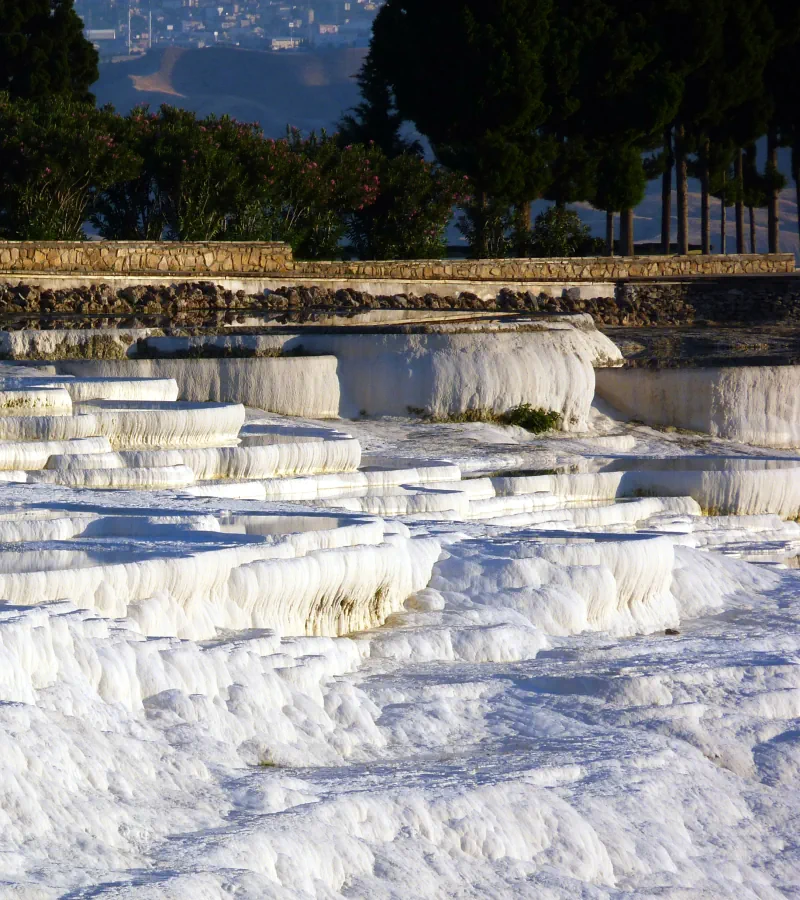
RICH IN FERROUS OXYDE
Yellowstone Park is also an exceptional laboratory for studying the many hot springs covered in ferrous oxide. In fact, there are more than a dozen scattered across several sectors of the park. Here are some pictures :
According to these studies, these iron rich hot springs have considerable microbial diversity detected on their ferric iron mats[12][13].
These bacterial strains regulate the forms of iron present in hot springs. When iron is transformed and oxidised by microorganisms, it can accumulate in minerals composed of iron oxide[14], of which there is a great variety (haematite, goethite, jarosite, scorodite, etc.).
The thickness and hardness of these minerals[12] are also influenced by these microbial communities…
Another hot spring at PAMMUKALE (Karahayit) in Turkey, rich in iron and calcium, allows micro-organisms to regulate and incorporate these minerals into the formation of complex travertines, this time with a reddish hue. In fact, this red mud and its thermal waters are renowned for their therapeutic properties.
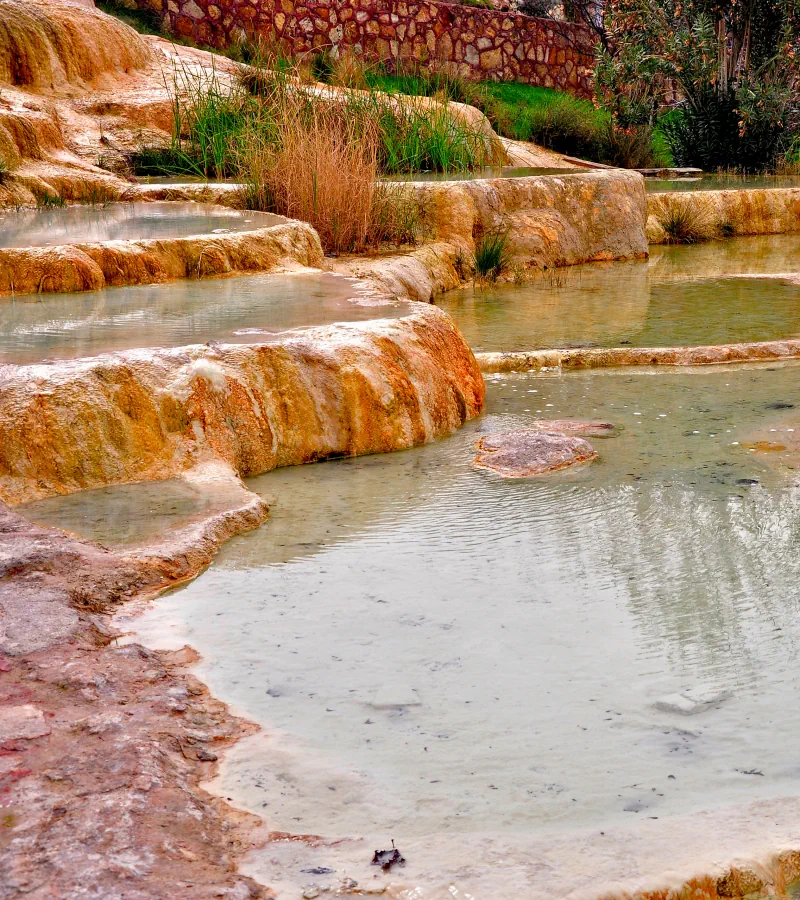
Abundance and diversity of microorganisms in a hot spring
Certain factors seem to play a decisive role in the abundance and diversity of microorganisms in the soil and thermal water of a hot spring.
→ As we have already indicated, temperature[7] is an important factor that determines the presence of certain species of micro-organisms. It controls the richness and composition of bacterial communities at all taxonomic levels.
Temperature has many effects on the physical and chemical properties of water. As temperature increases, certain properties of water such as viscosity, density, refractive index, pH, oxygen solubility, surface tension, etc. decrease, while certain properties such as volume and the solubility of organic and inorganic compounds in water increase. For example, the pH of pure water is 7 at 25°C, 7.47 at 0°C and 6.77 at 40°C. All these tiny variations affect bacterial diversity.
After emerging at a certain temperature, the water from a hot spring cools along the way, creating a thermal gradient at the surface of the ground.
In addition, the temperature of the water from a hot spring produces a temperature gradient across the ground, by moistening the lower layers to a certain depth.
The depth reached depends on the capacity of the soil to retain surface water, the nature of the soil, the flow rate, etc. Microbial diversity is therefore favoured by a wide range of underground temperatures throughout the hot spring site.
It would also appear that temperature has an inverse influence on the degree of microbial diversity. The lower the temperature, the greater the species richness[7]. (as shown by our example of the Umpqua hot spring and its tiered basins in OREGON, USA).
→ pH is also a factor that influences microbial diversity. An alkaline environment generally favours the presence of basophilic bacteria, although this is not always the case. A study[15] of an alkaline Malaysian hot spring found that acidophilic bacteria were also present.
→ Water chemistry parameters, various metallic elements and certain sediment properties also influence microbial abundance, diversity and structure.
Nutrition and diversity of soil micro-organisms
Bacteria developing in the soil and/or in the water of the hot spring (flowing to the surface) draw their nutrients directly from the hot springs. These nutrients can be amino acids, reduced chemical species, solutes, the heat of the water (which is energy), etc. Photosynthetic bacteria also use light energy to grow. In this case, they develop in the water flowing over the surface.
Soil bacteria are called “chemoautotrophic” because they can produce organic compounds without the need for light. They do this by using the minerals available to them as a source of energy and dissolved carbon dioxide (CO₂) as a source of carbon.
The natural environment around a hot spring can also be a good source of carbon [15]. A hot spring in a forest will collect a variety of organic matter (plant debris, leaves, bark, animals, insects, etc.) that will be available to the bacterial community. This additional carbon source improves their survival and activity and increases microbial diversity.
The role played by these microorganisms in the soil of a hot spring and how they interact with each other.
A hot spring provides chemical elements essential to life and supports microbial ecosystems with abundant sources of energy. Rich in nutrients, it supports both the photosynthetic communities present in the water (algae and bacteria that make up the thermal plankton) and the microbial communities that can develop in the absence of light, i.e. the soil.
Microbial communities can then reciprocally support the hot spring environment through a range of interactions, such as with minerals. For example, minerals can serve as sources of energy and electrons for microbes, or can be used to form complex structures and deposits. Minerals can also receive electrons from microbes. Their bioavailability depends in part on complex interactions with these soil microorganisms.
When the temperature of a hot spring decreases (after emergence) through the medium (the soil) in which it flows, the latter must supply the water with electrons in order to limit its oxidation so that it maintains its vitality. These electrons are provided by soil micro-organisms. Through their energy metabolism, the soil micro-organisms convert the nutrients supplied by the hot spring into energy which they release back into the water.
Micro-organisms produce a very large number ofenzymes[16] in hot springs. Enzymes make it possible to accelerate (catalyse) the chemical reactions that take place in an aqueous medium millions of times over. Biological decontamination (bio-remediation) using enzyme-producing micro-organisms is by far the most effective method of water treatment , according to one study[17], and even superior to the many physical and chemical methods.
Hot springs are a source of antibiotics[18] due to the presence of microorganisms that secrete antimicrobial compounds. In particular, this helps to control and prevent the proliferation of pathogenic bacteria in the soil and also in the water. What’s more, the antibiotics produced can have a broad-spectrum effect on pathogenic bacteria, as shown by this study[19] carried out on several hot springs in India.
A diversity of soil micro-organisms is also more likely to produce a diverse chemistry, which increases the likelihood of finding a variety of compounds (sugars, saturated and unsaturated fatty acids, anti-inflammatory molecules, vitamins, etc.) to enrich a hot spring.
The microbiota of a hot spring soil
There are many similarities between the microbiota of the gut, with its diversity of micro-organisms living in symbiosis with this specific environment, and that of a hot spring. Can we even speak of a microbiota for a hot spring? That’s what we’re going to look at in this last part. We’re going to look at the “bacterial phyla” that have been identified in hot springs. A “phylum” is simply a “class” of bacteria. There are currently around sixty phyla, which refer to all known bacteria.
According to the classification, there can be thousands of species of bacteria in a single phylum (e.g. the phylum ‘Firmicutes’, the phylum ‘Proteobacteria’, the phylum ‘Cyanobacteria’, while others have only a few).
Bacterial diversity and phyla in South Asian hot springs
A particularly interesting meta-analysis [20] brings together several publications on the bacterial diversity of numerous hot springs in South Asia (India, China and northern Pakistan).
An important note: the samples taken from all these hot springs were of water, sediment (soil) and agglomerate (soil), and were taken at a specific temperature. This study summarises all these publications).
This graph (fig. 2) shows the abundance and diversity of bacterial phyla in more than 70 South Asian hot springs.
Each hot spring is characterised by certain bacterial phyla that are more dominant than others. These may be the phylum ‘Firmicutes’, ‘Proteobacteria’ or ‘Aquificae’… In adult humans, the dominant bacterial phylum is the Firmicutes, followed by the Bacteroidetes. These two phyla account for up to 90% of the human microbiota. So we can indeed speak of a microbiota for a hot spring.
Diversity, bacterial phyla and species present in the soil of a hot spring in India
In this study[21], soil samples from a hot spring in Tapovan (UTTARAKHAND, India) were collected for analysis. 14 bacterial phyla with 486 species were identified. The dominant bacterial phyla are represented by Firmicutes (63%), Proteobacteria (19.99%) and Thermi (12.79%)…
The Proteobacteria phylum accounts for 19.99% of the soil microbiota in this hot spring. In humans, it is the third most abundant phylum in the microbiota, after Firmicutes and Bacteroidetes. It has been identified in the intestine, stomach (gastric species), liver (enterohepatic species), lungs, etc.
The number of bacterial species identified in the soil of this hot spring is 486, compared to the average human microbiota of 160. The diversity of species in the soil of this hot spring is therefore considerable.
But their populations must also be stable in a balanced ecosystem. What would happen, for example, if some species disappeared while others increased or decreased? Let’s take a look at what might happen to the human gut microbiota.
According to a French study[22] on irritable bowel syndrome, microbial diversity plays an important role in the disease. A loss of microbial diversity, accompanied by a decrease in certain Firmicutes species (Lachnospiraceae, Gammaproteobacteria, Enterobacteriaceae and Escherichia coli species), followed by a slight increase in certain Bacteroidetes species (Clostridium, Streptococcus and Bifidobacterium), is found in all patients with this disease. We can therefore see that slight variations up or down in certain species, in the specific environment of the gut, affect the health of the individual.
Conclusion
The micro-organisms in the soil of a hot spring therefore live in a stable, organised ecosystem with all the characteristics of a microbiota. This microbiota even has the peculiarity that its bacterial diversity evolves along its course, due to the wide range of temperatures that can be found in a “whole site”. As we have seen, an increase in bacterial diversity increases the likelihood of finding a variety of beneficial compounds that enrich a hot spring as it cools. What’s more, this rich ecosystem, which is essential to the survival and vitality of a hot spring, makes it a fascinating environment. In fact, this extremely complex environment is considered to be one of the richest on the planet and continues to be of great interest to the scientific community in many ways.
(In this article, we have mainly referred to bacteria when talking about microorganisms, but the soil of a hot spring is also made up of archaea, filamentous yeasts and viruses, just like the human microbiota).
References
1. Glassman SI, Weihe C, Li J, Albright MBN, Looby CI, Martiny AC, Treseder KK, Allison SD, Martiny JBH. “Decomposition responses to climate depend on microbial community composition.” 5 novembre 2018 | 115(47):11994-11999 | doi: 10.1073/pnas.1811269115
2. Allison SD, Lu Y, Weihe C, Goulden ML, Martiny AC, Treseder KK, Martiny JB. “Microbial abundance and composition influence litter decomposition response to environmental change.” Ecology. 1 mars 2013; 94(3):714-25. PMID: 23687897.
3. Masson, Anne-Sophie. 2021. “Le Microbiote Associé Aux Racines De Riz Dans Un Contexte D’Infection Par Des Nématodes Phytoparasites : Une Approche Écologique D’un Système Plante-Pathogène”. Inria.Hal.Science. https://inria.hal.science/tel-03572406v1.
4. Fester, Thomas, Julia Giebler, Lukas Y Wick, Dietmar Schlosser, and Matthias Kästner. 2014. “Plant–Microbe Interactions As Drivers Of Ecosystem Functions Relevant For The Biodegradation Of Organic Contaminants“. Janvier 2014; Current Opinion In Biotechnology 27: 168-175. doi:10.1016/j.copbio.2014.01.017.
5. “De L’Eau Chaude Pour Contrôler La Végétation Sur Les Voies Ferrées – Agrarforschung Schweiz”. 2023.
6. Rawat, Nivedita, and Gopal Krishna Joshi. 2019. “Bacterial Community Structure Analysis Of A Hot Spring Soil By Next Generation Sequencing Of Ribosomal RNA“. 8 Juin 2018; Genomics 111 (5): 1053-1058. doi:10.1016/j.ygeno.2018.06.008.
7. Cole, J., Peacock, J., Dodsworth, J. et al. “Sediment microbial communities in Great Boiling Spring are controlled by temperature and distinct from water communities“. ISME J 7, 718–729 (2013). https://doi.org/10.1038/ismej.2012.157
8. Fouke BW, Farmer JD, Des Marais DJ, Pratt L, Sturchio NC, Burns PC, Discipulo MK. “Depositional facies and aqueous-solid geochemistry of travertine-depositing hot springs“ (Angel Terrace, Mammoth Hot Springs, Yellowstone National Park, U.S.A.). J Sediment Res A Sediment Petrol Process. Mai 2000; 70(3):565-85. PMID: 11543518.
9. Fouke BW. “Hot-spring Systems Geobiology: abiotic and biotic influences on travertine formation at Mammoth Hot Springs, Yellowstone National Park, USA”. 17 Janvier 2011; https://onlinelibrary.wiley.com/doi/10.1111/j.1365-3091.2010.01209.x
10. Venturi S, Crognale S, Di Benedetto F, Montegrossi G, Casentini B, Amalfitano S, Baroni T, Rossetti S, Tassi F, Capecchiacci F, Vaselli O, Fazi S. “Interplay between abiotic and microbial biofilm-mediated processes for travertine formation: Insights from a thermal spring“ (Piscine Carletti, Viterbo, Italy). Geobiology. 2022 Nov;20(6):837-856. PMID: 35942584.
11. Ciplak ES, Bilecen K, Akoglu KG, Guchan NS. Use of bacterial binder in repair mortar for micro-crack remediation. Appl Microbiol Biotechnol. 2023 May; 107(9):3113-3127. Epub 2023 Apr 4. PMID: 37014395.
12. Konhauser, K. (Mai 1998). Diversity of bacterial iron mineralization. Earth-Science Reviews, 43(3-4), 91-121. doi: 10.1016/s0012-8252(97)00036-6
13. Inskeep, W., Macur, R., Harrison, G., Bostick, B., & Fendorf, S. (Août 2004). Biomineralization of As(V)-hydrous ferric oxyhydroxide in microbial mats of an acid-sulfate-chloride geothermal spring, Yellowstone National Park. Geochimica Et Cosmochimica Acta, 68(15), 3141-3155. doi: 10.1016/j.gca.2003.09.020
14. Kozubal MA, Macur RE, Jay ZJ, Beam JP, Malfatti SA, Tringe SG, Kocar BD, Borch T, Inskeep WP. Microbial iron cycling in acidic geothermal springs of yellowstone national park: integrating molecular surveys, geochemical processes, and isolation of novel fe-active microorganisms. Front Microbiol. 2012 Mar 26;3:109. ; PMC3312321.
15. Chan, Chia Sing, Kok-Gan Chan, Yea-Ling Tay, Yi-Heng Chua, and Kian Mau Goh. 2015. “Diversity Of Thermophiles In A Malaysian Hot Spring Determined Using 16S Rrna And Shotgun Metagenome Sequencing“. 5 mars 2015; Frontiers In Microbiology 6. doi:10.3389/fmicb.2015.00177.
16. Alrumman S, Mostafa YSM, Al-Qahtani S, Taha THT. Hydrolytic Enzyme Production by Thermophilic Bacteria Isolated from Saudi Hot Springs. Open Life Sci. 2018 Dec 5; PMCID: PMC7874730.
17. Mousavi SM, Hashemi SA, Iman Moezzi SM, Ravan N, Gholami A, Lai CW, Chiang WH, Omidifar N, Yousefi K, Behbudi G. Recent Advances in Enzymes for the Bioremediation of Pollutants. Biochem Res Int. 2021 Jun 22; 2021:5599204. PMCID: PMC8364428.
18. Mahajan, Girish B., and Lakshmi Balachandran. 15 Juin2017. “Sources Of Antibiotics: Hot Springs“. Biochemical Pharmacology 134: 35-41. doi: 10.1016/j.bcp.2016.11.021.
19. Pednekar P, Jain R, Mahajan G. Anti-infective Potential of Hot-spring Bacteria. J Glob Infect Dis. 2011 Jul; 3(3):241-5. PMC3162810.
20. Najar, Ishfaq Nabi, Prayatna Sharma, Sayak Das, Mingma Thundu Sherpa, Santosh Kumar, and Nagendra Thakur. 2022. “Bacterial Diversity, Physicochemical And Geothermometry Of South Asian Hot Springs”. Current Research In Microbial Sciences 3: 100125. doi:10.1016/j.crmicr.2022.100125.
21. Rawat, Nivedita, and Gopal Krishna Joshi. 2019. “Bacterial Community Structure Analysis Of A Hot Spring Soil By Next Generation Sequencing Of Ribosomal RNA“. Genomics 111 (5): 1053-1058. doi:10.1016/j.ygeno.2018.06.008.
22. Lajoie, Frédérique, Guy Rousseau, Stéphanie Blanquet-Diot, and Lucie Etienne-Mesmin. 2021. “Syndrome De L’Intestin Irritable”. Médecine/Sciences 37 (6-7): 593-600. doi:10.1051/medsci/2021095.


